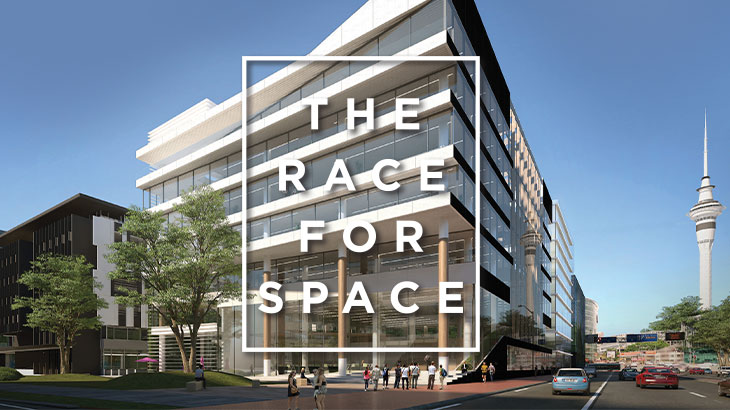The race for space
Auckland vacancy rates have trended down to historic lows and this has put upward pressure on rentals.
The development response will ease pressure through to early 2021 as major projects are completed. However, Bayleys Research sees little prospect of a significant oversupply of space, as beyond 2021 development will slow.
The investment sector remains extremely competitive, with overseas funds adding to a local investor pool chasing higher-yielding assets. The competition has boosted values which, in tandem with rising rents, has driven attractive total returns.
Since 2010, creation and expansion of businesses has lifted Auckland’s white-collar workforce by 34 percent to over 230,000, according to Statistics New Zealand.
The sharp lift in sentiment in ANZ’s Business Outlook survey late last year points towards further workspace demand.
Vacancy across all precincts in the latest Bayleys Research survey was a historically low 5.4 percent; it has stood below seven percent since mid-2016. Leasing activity has remained strong, with tight market conditions seeing companies such as BBDO and AECOM abandoning relocations.
The new office building at 155 Fanshawe Street has been leased with Kiwibank, Southern Cross Healthcare and IWG, well ahead of completion.
Recent years have seen a spike in development. The net effect has been muted as lower quality premises are removed for refurbishment or for conversion, primarily to apartments and hotels.
As a result, the CBD is seeing a lift in office quality but little increase in quantity, with stock hovering around 1.4 million square metres.
Hotel conversions have seen removals including the ex-Reserve Bank building at 67 Customs Street East, and 396 Queen Street. Inventory will lift in 2020 with completion of Commercial Bay, 155 Fanshawe Street and 10 Madden Street, which together will add 62,500 square metres.
New supply will then slow. In the year to June 2019, 29,000 square metres of new office development was consented in central Auckland, down from a five-year average of 48,000 square metres.
CBD office assets generated total returns of 13 percent in the year to June 2019, according to MSCI figures, having sat close to, or over, 10 percent since 2013.
Overseas investors account for nearly half of sales over $20 million. Since January 2014, they have invested $7.3 billion in New Zealand commercial property. Office assets account for half of these sales by value.
In Wellington, market conditions tightened due to inventory losses after the 2016 Kaikoura earthquake and demand fuelled by relocations and expansion in the government and business sectors.
A number of lower-grade buildings have been converted, particularly for accommodation.
Between 2016 and 2019, the city’s white-collar employment rose by 3,800. Tight market conditions, with prime office vacancy below one percent, have prompted a development response.
In the year to November 2019, building consents were granted for $131 million of office development; the average since 2000 is $75 million.
Conditions at the upper end of the quality scale will likely remain tight as tenants have been secured for much space under construction.
Statistics New Zealand will move into 11,800 square metres of new space at 8-14 Willis Street. Its previous headquarters were demolished after the 2016 quake.
Greater Wellington Regional Council, also displaced by the quake, has committed to space within Willis Bond’s Cuba Street redevelopment.
Earthquake-strengthening has been completed at 10 Brandon Street with fit-out underway for the Law Society and design and consultancy firm Stantec.
BNZ’s headquarters were also decommissioned post the 2016 quake. Some 1,500 staff will occupy a new earthquake-resilient, 12-storey building at 1 Whitmore Street.
Office investment stock is tightly held. Historically low vacancy has put upward pressure on rentals, boosting cash returns and disincentivising sales. Demand, however, remains strong. Quality buildings with long-term tenants are likely to sell for a yield of six percent or lower.
The largest office sale of 2019 was of Matauranga House at 33 Bowen Street, occupied by the Ministry of Education, to European investors for $82 million.
MSCI figures show a 12.6 percent total return for Wellington office assets in the year to September 2019, up from 4.2 percent in 2017.
Meanwhile, the Christchurch CBD office market is showing signs of stabilising as the development pipeline unwinds and tenants return to the revamped city centre. This migration has led to vacancies on the city fringe.
A surge in CBD development from 2012 to 2017 saw an oversupply of space, though development has slowed. Building-consents for 8,400 square metres of new office space were approved in the year to November 2019, compared with 170,000 square metres in 2014 and 2015.
Slowing development will further reduce CBD vacancy and bring stability to rentals.
Read more market insights from Total Property
Subscribe to receive the latest commercial news and insights from Bayleys Total Property
